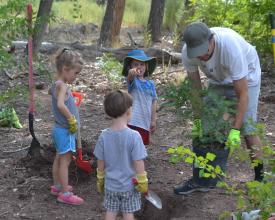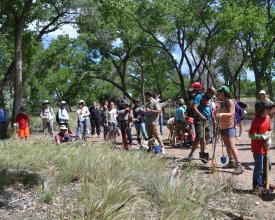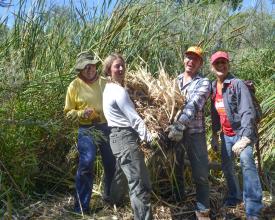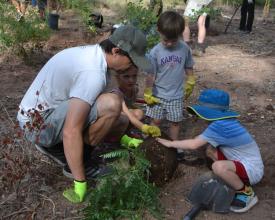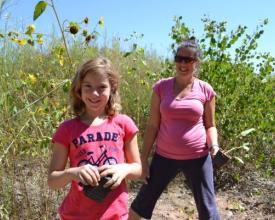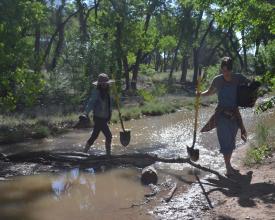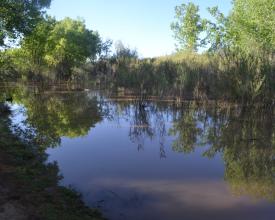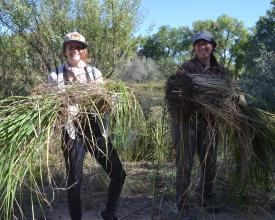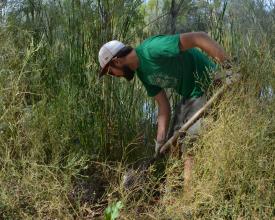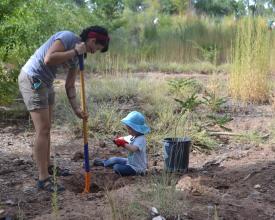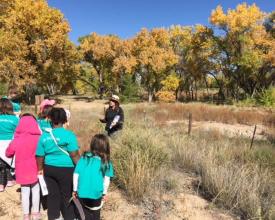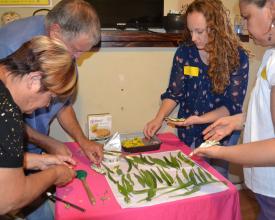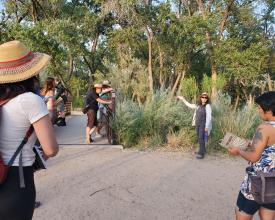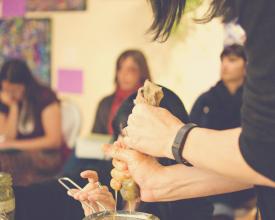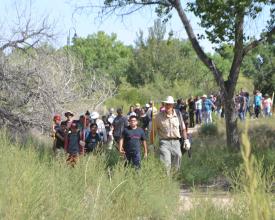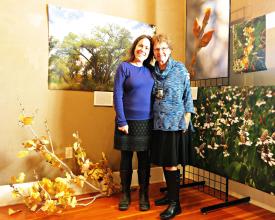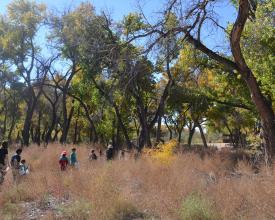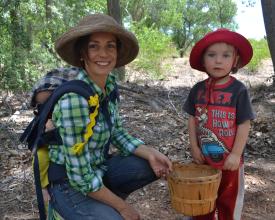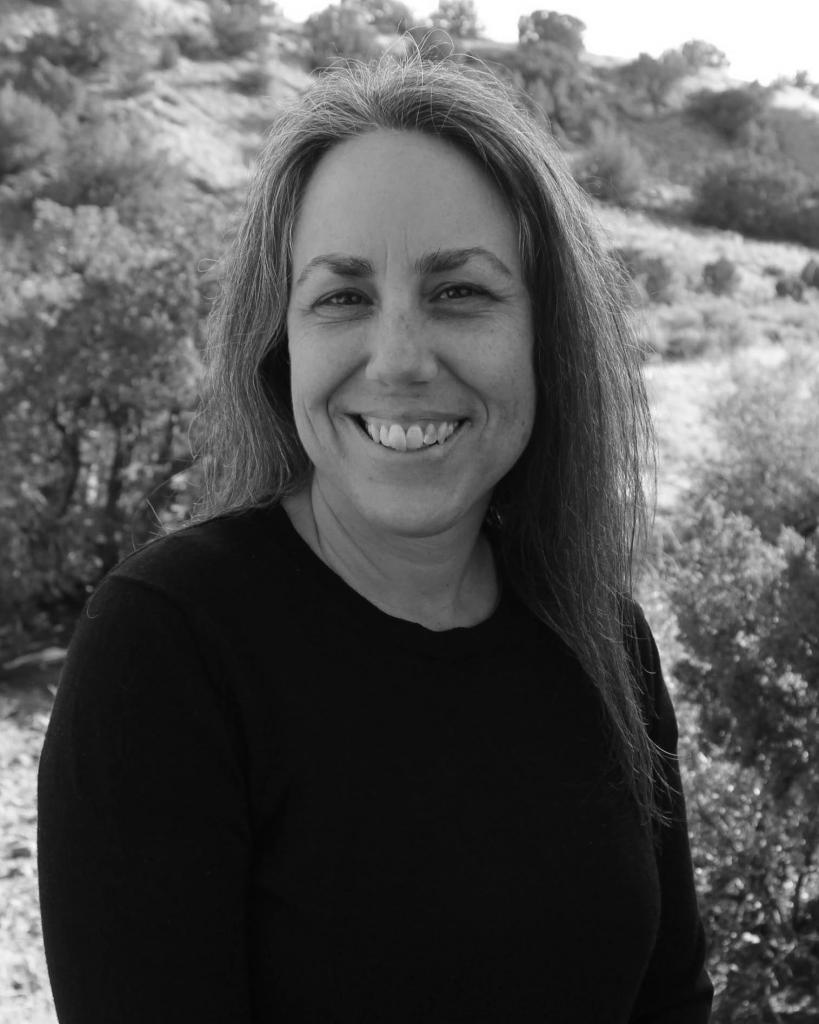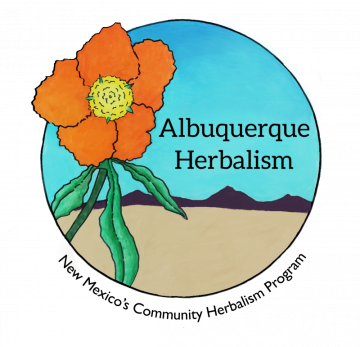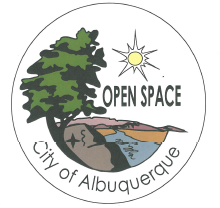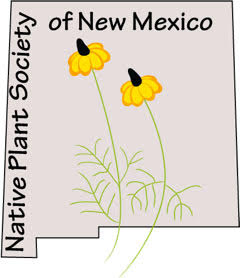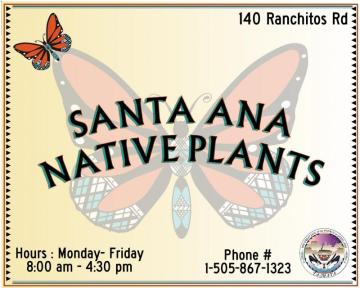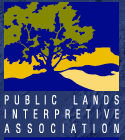
Yerba Mansa Project
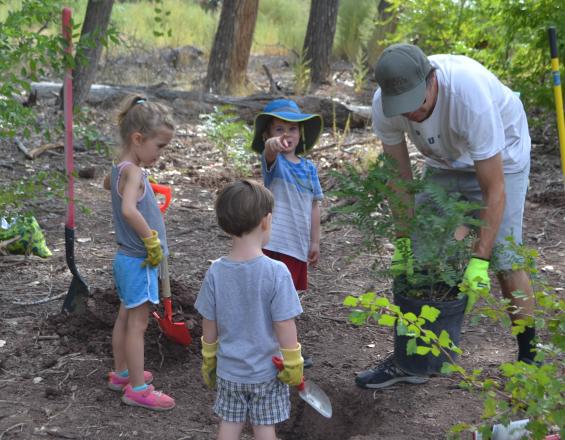
Het Yerba Mansa Project (YMP) is een in Albuquerque gevestigde, door de gemeenschap gesteunde non-profitorganisatie die in 2014 is gestart om de verbinding tussen mensen, planten en het land in de Midden Rio Grande Valley te herstellen. Ons werk met het Rio Grande Valley State Park ondersteunt de gezondheid van ecologisch en cultureel belangrijke inheemse eetbare en geneeskrachtige planten en biedt mensen de mogelijkheid om hun rol in het verzorgen van ons land en het in stand houden van onze culinaire en geneeskrachtige tradities opnieuw op te eisen. Regionale botanische geneeswijzen zijn van toenemend belang nu we een pandemie doormaken en zullen een integraal onderdeel blijven van het welzijn van mensen in de toekomst. Onze vrijwilligers werken aan het herstel van enkele van onze meest legendarische voedzame en geneeskrachtige planten, leren jongeren en volwassenen over hun belang en helpen kritieke habitats en bijbehorende culturele kennis te beschermen voor huidige en toekomstige generaties.
Context
Uitdagingen
Het YMP is opgericht als reactie op de achteruitgang van het ecosysteem in het Rio Grande Bosque (oevergebied) en het culturele belang van veel inheemse planten die in dit gebied voorkomen. Gedurende de laatste 150 jaar hebben uitgebreide maatregelen voor overstromingsbeheer, omleiding van water, oppompen van grondwater en landconversie geresulteerd in:
- ernstige veranderingen in het ecosysteem,
- snelle achteruitgang van inheemse planten, waaronder belangrijke soorten ( Populus deltoides wislizeni en Salix sp. wilgen),
- proliferatie van niet-inheemse invasieve soorten(Tamarix sp., Saccharum ravennae, etc.),
- en toegenomen brandgevaar.
Deze verslechtering van het milieu houdt direct verband met culturele praktijken met betrekking tot inheemse eetbare en medicinale soorten zoals yerba mansa(Anemopsis californica) en andere soorten die afhankelijk zijn van oppervlaktestromen en grondwater. Deze veranderingen hebben een negatieve invloed op het vermogen van de bewoners om zich bezig te houden met kosteneffectieve culinaire en genezende tradities die de gezondheid al lange tijd ondersteunen en die gezien de pandemie van toenemend belang zijn.
Locatie
Proces
Samenvatting van het proces
De bouwstenen van het Yerba Mansa Project kruisen elkaar als de gezondheid van het land en de mens met elkaar verweven zijn en partnerschappen in de gemeenschap vooruitgang voor beide mogelijk maken. We zien het wederzijdse herstel van ecosystemen en cultuur door middel van inheemse eetbare en geneeskrachtige planten. Het herstel van inheemse soorten en kritieke habitats verbetert de biodiversiteit en ondersteunt de functies van ecosystemen, terwijl het mensen in contact brengt met natuurlijke omgevingen en met het land. Educatie over de rol van inheemse planten in ecologische systemen en als voedende helende componenten in ons leven bevordert investeringen in het duurzame werk van herstel en moedigt mensen aan om zorg te dragen voor kritieke habitats, wilde plantenpopulaties te beheren en gezond voedsel en remedies te bereiden die voortkomen uit lokale landschappen. Hoewel welzijn op basis van de natuur, kruidenremedies en wilde voeding de afgelopen jaren aan populariteit hebben gewonnen, heeft de pandemie deze onderwerpen op de voorgrond geplaatst nu velen van ons geconfronteerd worden met de realiteit van ziektepreventie, thuiszorg en voedselschaarste. Het planten van inheemse eetbare en geneeskrachtige planten en het bevorderen van de voortzetting van lokale botanische culinaire en genezende tradities zal ons helpen om 'beter terug te bouwen' na de pandemie door veerkracht in het land en de mensen te stimuleren.
Bouwstenen
Restauratie van inheemse eetbare en geneeskrachtige planten
Deze bouwsteen vormt de basis van het werk van het Yerba Mansa Project. Gezonde en diverse inheemse plantengemeenschappen zijn essentieel voor het functioneren van ecosystemen en de culturele tradities die erop gebouwd zijn. Onze vrijwilligers planten en herzaaien eetbare en medicinale soorten die van oudsher aanwezig zijn geweest en die zich kunnen aanpassen aan de huidige en toekomstige klimaatomstandigheden, waaronder hogere temperaturen en minder water in het oeversysteem. Het herstelwerk omvat ook habitatverbeteringen zoals het verwijderen van niet-inheems invasief ravennagras(Saccharum ravennae) dat de groei en voortplanting van inheemse soorten belemmert. Ons werk heeft aangetoond dat ravennagras met succes kan worden verwijderd met handgereedschap zoals schoppen en matten en als de wortels goed worden verwijderd, schieten de planten niet opnieuw uit. Dit dient als model voor landbeheerders die inheemse onderliggende planten langs waterwegen in het Amerikaanse westen willen bestrijden zonder chemische middelen te gebruiken. De combinatie van het verwijderen van invasieve soorten en het herstellen van inheemse planten is succesvol gebleken als de juiste soorten worden geselecteerd op basis van hun geschiktheid voor het klimaat en culturele relevantie.
Sleutelfactoren
Deze bouwsteen vereist dat er rekening wordt gehouden met twee kritieke factoren. Ten eerste moet er een minimale standaard van ecosysteemfuncties aanwezig zijn om inheemse plantensoorten te kunnen herstellen. In dit geval moet er voldoende water in de stromen zijn en moet het grondwaterpeil hoog genoeg zijn om toegankelijk te zijn voor gevestigde planten. Ten tweede moeten soorten worden geselecteerd op basis van hun vermogen om zich aan te passen aan de voorspellingen voor klimaatverandering in de komende decennia. Deze omvatten vroegere voorjaarsafvloeiing in rivieren, minder water in het systeem door toegenomen verdamping en economisch gebruik, en hogere temperaturen.
Geleerde les
We hebben geleerd om te anticiperen op en ons aan te passen aan milieuomstandigheden die onverwacht veranderen en een negatieve invloed hebben op het vermogen van planten om te overleven. Bevers vellen bijvoorbeeld bomen die schaduw bieden tijdens de aanplant van nieuwe planten. In een ander geval kreeg onze locatie te maken met 'historische' overstromingen die nieuwe aanplant, geselecteerd voor warmere en drogere omstandigheden, onder water zetten. Ook is ons gebied een beschermd natuurgebied in een stedelijke omgeving en wordt het dus veel gebruikt door bezoekers en aangetast door wandelen buiten de paden en loslopende honden. Aan al deze omstandigheden moet tegemoet worden gekomen omdat ze de wildheid van de natuur vertegenwoordigen, de chaos van het veranderende klimaat en de druk van de bevolkingsgroei.
Vergelijkbare zorgen zullen waarschijnlijk andere restauratieprojecten op verschillende locaties treffen en kunnen met flexibiliteit worden opgevangen. Om rekening te houden met gekapte schaduwbomen en intensief gebruik door bezoekers, hebben we de gewoonte ontwikkeld om neergehaald puin van doornige planten zoals tumbleweed(Salsola tragus) en Russische olijf(Elaeagnus angustifolia) te verzamelen en dit bovenop of rond planten te leggen om schaduw te bieden en wandelaars en honden af te schrikken om door het gebied te lopen.
Onderwijs over culturele praktijken in verband met inheemse soorten
Het Yerba Mansa Project biedt gratis educatieve programma's voor het grote publiek en schoolklassen. Deze evenementen omvatten activiteiten die mensen in contact brengen met het land en de planten en zijn geschikt voor een breed publiek. Langzame wandelingen door gemakkelijk begaanbaar terrein bieden mensen van alle leeftijden en fysieke mogelijkheden de gelegenheid om de planten om hen heen te leren kennen en het belang ervan voor het land, hun families en henzelf in te zien. Lessen waarin het maken van botanische remedies en het verwerken van wild voedsel centraal staan, stimuleren de praktische vaardigheden die nodig zijn om direct en veilig met planten te werken voor een beter welzijn en een diepere waardering van en verbondenheid met het land. Het aanleren van tuinieren en het kweken van populaire inheemse medicinale planten die onder druk staan van hun habitat creëert mogelijkheden voor een verbeterde stedelijke habitat, gemakkelijke toegang tot helende en voedzame planten en vermindert de druk op wilde populaties. Ook het aanbieden van gratis programma's voor schoolklassen, zoals beschreven in het gedeelte "Inspirerend verhaal", brengt de volgende generatie in de natuur en biedt hoop voor toekomstige oplossingen. Al deze praktijken bestendigen de culturele tradities die verbonden zijn aan onze lokale gronden en zorgen ervoor dat toekomstige generaties toegang hebben tot deze kennis en de planten die eraan ten grondslag liggen.
Sleutelfactoren
Het creëren van succesvolle educatieve evenementen vereist brede steun van de gemeenschap. De meeste evenementen van het Yerba Mansa Project worden gesponsord door andere organisaties, waaronder openbare bibliotheken, stedelijke en provinciale open ruimte instanties, milieu- of natuurbeschermingsgerichte non-profits, openbare en particuliere scholen, of lokale bedrijven die onze waarden en missie delen. Deze samenwerkingsverbanden zorgen voor financiële steun, een groter vermogen om nieuwe sectoren van onze gemeenschap te bereiken en mogelijkheden voor kruisbestuiving van soortgelijke inspanningen van alle organisaties.
Geleerde les
Terwijl we onze educatieve programma's verder ontwikkelden en verbeterden, leerden we over het uitwissen of minimaliseren van bepaalde culturele groepen, in het bijzonder inheemse gemeenschappen. Een belangrijke toevoeging aan al onze evenementen is dat we beginnen met een landverkenning. Een landerkenning is een manier om de mensen te eren die het land waarop we ons bevinden al sinds mensenheugenis beheren en erkent ook de diepgaande ecologische en culturele kennis die deze gemeenschappen bezitten. Het biedt ook een opening om de rol van koloniaal beleid en modern economisch land- en watergebruik te bespreken die een negatieve invloed hebben op het land, het water, de lucht, de planten, de dieren en de mensen. Het is een uitnodiging voor alle mensen van onze gemeenschap om samen te komen om te bespreken hoe we elkaar kunnen respecteren, van elkaar kunnen leren en een gemeenschappelijke basis kunnen vinden in onze gezamenlijke investering in de gezondheid van land en mensen.
Maatschappelijke partnerschappen en bijeenkomsten voor meerdere generaties
Het succes van het Yerba Mansa Project is afhankelijk van het opbouwen van een gemeenschap. Dit omvat ondersteunende en samenwerkingsrelaties met een verscheidenheid aan instellingen, waaronder openbare bibliotheken, overheidsinstanties voor landbeheer, non-profits gericht op milieu of natuurbehoud, scholen in de omgeving of lokale bedrijven die onze waarden en missie delen. Deze wederzijds voordelige partnerschappen zorgen voor belangrijke donaties en financiële steun, nieuwe ideeën en expertise, juridische dekking voor evenementen en brengen ook verschillende mensen samen die verschillende interesses en connecties kunnen hebben. Lokale scholen moeten bijvoorbeeld voldoen aan leerplanvereisten op verschillende gebieden en kunnen dat bereiken door deel te nemen aan educatieve evenementen die ook de doelen van uw programma's bevorderen. Landbeheerders kunnen ondersteuning bieden en baat hebben bij de bestrijding van invasieve soorten op hun terreinen. Dergelijke partnerschappen kunnen zelfs verplicht zijn, zoals in het geval van werken op openbaar terrein. Extra mogelijkheden om een gemeenschap op te bouwen zijn er door evenementen aan te bieden die toegankelijk en interessant zijn voor alle leeftijden. Door gezinnen met kinderen aan te spreken leg je de basis voor de voortgang van de missie van je programma in de toekomst, terwijl je activiteiten ontwerpt die de deelname van ouderen aanmoedigen en hun kennis en ervaring inbrengt.
Sleutelfactoren
De steun en deelname van de gemeenschap nemen toe als activiteiten interessant zijn en betekenis hebben voor een verscheidenheid aan mensen, aansluiten bij de doelen van andere gelijkgestemde organisaties en breed toegankelijk zijn. Met andere woorden, programma's moeten iets weerspiegelen dat de gemeenschap verenigt. In het geval van YMP is onze oeverhabitat om veel verschillende redenen geliefd bij veel verschillende mensen en belichaamt het onze gedeelde waarden van land en cultuur. Onze evenementen zijn all-inclusive en bieden rollen voor mensen met fysieke beperkingen of praktische activiteiten voor kinderen.
Geleerde les
Naarmate we meer gesponsorde evenementen organiseerden, waar een grotere verscheidenheid aan mensen op af kwam, leerden we hoe we onze evenementen toegankelijker konden maken. Restauratiewerk in het veld kan fysiek erg veeleisend en vermoeiend zijn. Om ouderen en anderen met fysieke beperkingen erbij te betrekken, ontwierpen we activiteiten die weinig impact hadden. Sommige mensen waren bijvoorbeeld beter in staat om mee te doen als ze de opdracht kregen om samen met een assistent zaadkoppen van invasieve soorten te knippen en in een zak te doen terwijl ze op een schaduwrijke plek zaten. Voor veldlessen aan onze jongste leerlingen ontwikkelden we extra zintuiglijke en praktische activiteiten voor actievere lichamen.
De pandemie bood ook een kans om educatieve evenementen toegankelijker te maken. Door gratis online lessen via Zoom aan te bieden, konden we veilig deelnemen tijdens een besmettelijke uitbraak en mensen die in afgelegen plattelandsgebieden of andere staten woonden, toegang bieden. We pasten de lessen aan met fotografische diavoorstellingen voor discussies over de identificatie en het gebruik van planten. We gaven ook demonstraties van de bereiding van kruidenremedies en wilde voedingsmiddelen in de vorm van een kookshow.
Invloeden
Milieu:
Ondanks een pandemische onderbreking van 15 maanden hebben YMP-vrijwilligers meer dan 2000 uur in het veld gewerkt. Gevolgen vanaf 6/2021:
- Handmatige verwijdering van meer dan 2.000 niet-inheemse, invasieve ravennagras(Saccharum ravennae);
- Levend herplanten van 9 inheemse plantensoorten;
- Heraanplant van meer dan 8000 vierkante meter inheemse struiken, grassen en kruiden;
- Een dataset die vegetatieve veranderingen documenteert met foto's en geografische informatiesystemen die een aanzienlijk herstel van inheemse planten en een drastische vermindering van ravennagras laat zien.
Sociaal:
- Een jaarlijks gemiddelde van 10 gratis educatieve evenementen voor alle leeftijden van het grote publiek die bijeenkomsten voor meerdere generaties creëren;
- Grotere waardering voor de ecologische waarde van land en het culturele belang van eetbare en geneeskrachtige planten;
- Herinvestering in landbeheer en voortzetting van onze lokale botanische culinaire en genezende tradities;
- 16 scholen (K-12) betrekken bij herstelwerkzaamheden, gratis veldlessen en onderzoeksprojecten voor studenten;
- Het maken van de gratis online Planten van de Midden Rio Grande Bosque Veldgids (150 soorten) via iNaturalist.
Economisch:
- De herleving van inheemse wilde voeding en botanische genezingstradities verbetert de kwaliteit van leven en bespaart geld op boodschappen en medische rekeningen. Deze voordelen zijn uitgesproken voor de plattelandsbevolking met slechte toegang tot voedzaam voedsel en medische zorg.
- Het bereiken van minderbedeelde scholen met gratis educatieve veldprogramma's om aan de eisen van het leerplan te voldoen.
Begunstigden
De begunstigden van het Yerba Mansa Project zijn de Rio Grande uiterwaard, haar inheemse planten en dieren, de grotere gemeenschap van Albuquerque (900.000) en toekomstige generaties die de oplossing zullen erven en in stand houden.
Duurzame Ontwikkelingsdoelen
Verhaal
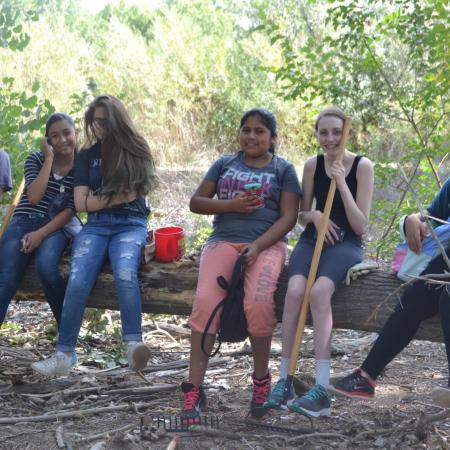
Het herstellen van land en inheemse planten is op zichzelf al verheffend, maar het is vooral inspirerend om de effecten op de jeugd van onze gemeenschap te zien. Het YMP betrekt iedereen bij onze ecologische en culturele rentmeesterschapsprogramma's, waarbij kinderen en tieners een prominente rol spelen. Schoolparticipatie brengt veel leerlingen naar dit landschap die het nog nooit eerder hebben bezocht en die geen betekenisvolle band hebben met het land en het culturele gebruik ervan. Door inheemse planten te planten, onderzoek te doen naar traditionele botanische praktijken, hun werk te publiceren in onze veldgids en deel te nemen aan excursies, ontdekken leerlingen enthousiasme voor het land en hun voorouders. Deelnemers melden dat ze weer contact maken met hun familielijn via grootmoeders en tantes die curanderas (genezers) zijn door vragen te stellen over de planten die ze onderzoeken. Op deze manier bestendigen onze jonge projectdeelnemers de culturele voortzetting van kennis over wilde voeding en medicijnen en erkennen ze hun rol als pleitbezorgers voor het land dat deze tradities in stand houdt. Leerlingen vertelden ons dat ze trots waren op het publiceren van gekoesterde familietradities in de veldgids als hulpbron voor anderen.
Naast het herstellen van familiebanden met het land door middel van botanische tradities, ontwikkelen jonge mensen belangrijke nieuwe percepties van ecologische en culturele verbondenheid om ons door een toekomst van klimaatveranderingen te helpen die het leven ongetwijfeld op diepgaande manieren zullen beïnvloeden. Jongere leerlingen zeggen dat ze zich nu verantwoordelijk voelen voor het land. Na het planten van struiken en kruiden komen ze met hun familie langs om de voortgang van de planten te controleren. Ouders vertellen ons dat hun kinderen gesprekken beginnen over het land als een levende entiteit en planten als intelligente wezens waarvan het leven gewaardeerd moet worden. De activiteiten van YMP dragen bij aan een hernieuwde toewijding aan wederzijds herstel van land en cultuur op lokaal niveau. Ons project heeft de potentie om een nieuwe generatie ecologische en culturele rentmeesters te stimuleren die de vereiste kennis en passie ontwikkelen om nieuwe initiatieven te ontplooien als professionals op het gebied van milieuwetenschappen, pleitbezorgers van duurzaam land- en waterbeleid en leiders op het gebied van cultuurbehoud.
"Mijn ervaringen met YMP zijn niets minder dan ongelooflijk geweest. Ik had het geluk om studenten mee te nemen op hun Ecology and Herbalism Bosque Walks in 2018 en 2019 en ze waren fantastisch..... Het werk dat ze doen is essentieel voor de gezondheid van de Bosque en de gemeenschap op de lange termijn." Jordy, docent biologie, AP milieuwetenschappen, aardrijkskunde op middelbare school

